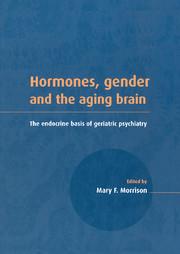Book contents
- Frontmatter
- Contents
- List of contributors
- Preface
- Acknowledgments
- Part I Overview
- Part II Hormones and mental health in the elderly
- 3 The hypothalamic–pituitary–adrenal axis in aging: preclinical and clinical studies
- 4 The hypothalamic–pituitary–thyroid axis
- 5 Estrogen and depression in aging women
- 6 The role of testosterone in male depression
- 7 Dehydroepiandrosterone in aging and mental health
- 8 Sex hormones, cognition, and dementia in the elderly
- 9 Effects of estrogen on basal forebrain cholinergic neurons and cognition: implications for brain aging and dementia in women
- 10 Gender and schizophrenia
- 11 Sex steroids and anxiety disorders
- 12 Gender and hormonal factors in pain and pain inhibition
- Part III Effects of hormones and behavior on immune function
- Part IV Hormones and gender differences in psychotropic drug metabolism
- Index
11 - Sex steroids and anxiety disorders
from Part II - Hormones and mental health in the elderly
Published online by Cambridge University Press: 18 September 2009
- Frontmatter
- Contents
- List of contributors
- Preface
- Acknowledgments
- Part I Overview
- Part II Hormones and mental health in the elderly
- 3 The hypothalamic–pituitary–adrenal axis in aging: preclinical and clinical studies
- 4 The hypothalamic–pituitary–thyroid axis
- 5 Estrogen and depression in aging women
- 6 The role of testosterone in male depression
- 7 Dehydroepiandrosterone in aging and mental health
- 8 Sex hormones, cognition, and dementia in the elderly
- 9 Effects of estrogen on basal forebrain cholinergic neurons and cognition: implications for brain aging and dementia in women
- 10 Gender and schizophrenia
- 11 Sex steroids and anxiety disorders
- 12 Gender and hormonal factors in pain and pain inhibition
- Part III Effects of hormones and behavior on immune function
- Part IV Hormones and gender differences in psychotropic drug metabolism
- Index
Summary
Introduction
Anxiety disorders are much more prevalent in women than in men, perhaps due to the role of sex steroids in women. In addition to their purported role in the pathophysiology of anxiety, reproductive hormone cycles may also have a substantial impact on the clinical course of pre-existing anxiety conditions throughout the life cycle in women. With these issues in mind, this chapter will provide: (a) an overview of the potential impact of gender and aging on the epidemiology and clinical features of anxiety disorders; (b) a discussion of estrogen and progesterone's potential role in the pathogenesis and pathophysiology of anxiety disorders in females; and (c) a review of available data concerning the impact of reproductive transitions on the course of anxiety disorders throughout the female life cycle.
Anxiety disorder overview
Anxiety disorders represent the most common psychiatric disorders in the United States, with epidemiological surveys revealing that one out of four people will experience a lifetime anxiety disorder. Anxiety disorders affect more than 7% of adults in the United States. Female gender, age (<45 years), marital separation or divorce, and low socioeconomic status are all associated with a higher rate of anxiety disorders (Kessler et al., 1994; Regier et al., 1990).
Generalized anxiety disorder (GAD), panic disorder, agoraphobia, social phobia, obsessive–compulsive disorder (OCD), simple phobia, and Post-Traumatic Stress Disorder (PTSD) are all classified as anxiety disorders in DSM-IV (American Psychiatric Association, 1994).
- Type
- Chapter
- Information
- Hormones, Gender and the Aging BrainThe Endocrine Basis of Geriatric Psychiatry, pp. 241 - 266Publisher: Cambridge University PressPrint publication year: 2000



